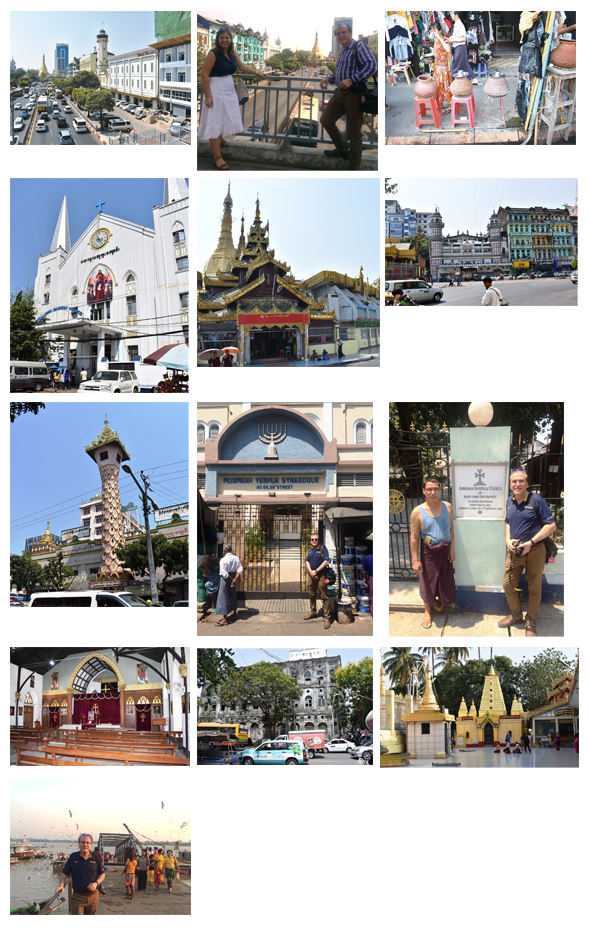Rich History of Religious Tolerance Among the Buddhist Faithful
Saved under Community, Current Stories, Travel
Tags: Desi news, Houston Desi news, India, Indian American community, Indian News, Indians in America, Indo-American News, Jawahar Malhotra, MYANMAR, NRI, pearland, religion, south asia, South India, Yangon

From left: Cars clog up the intersection of Sule Pagoda Road and Anawrahta Road, Sule Pagoda from the elevated walkway at Anawrahta Road, Water-filled Clay bowls are very common across Rangoon, offering a free with a steel mug of cold water to anyone, The Immanuel Baptist Church (opened 1885) across from City Hall. The Buddhist shrine at the 2,500 year-old Sule Pagoda across from City Hall, The Bengali Sunni Mosque behind the Sule Pagoda Buddhist shrine, The Maha Theindawgyi Buddhist temple, established in 1854, The Musmeah Yeshua Synagogue (consecrated in 1896) in the downtown area, With the caretaker of the Armenian Apostle Church, consecrated in 1863, The inside of the Armenian Apostle Church, The long-shuttered 1940’s era Gandhi Hall building on Merchant Street, Smaller shrine at the 2,500 year-old Botahtaung Pagoda complex by the YangonRiver, By the pier behind the Botahtaung Pagoda complex.
By Jawahar Malhotra
YANGON, MYANMAR: Remarkably fast changing Yangon – or as I fondly like to call it, Rangoon – is at a confluence of its modern history, with old buildings being torn down to make place for newer modern high-rises. My son Jeremy bemoaned the loss of the cinema hall on Bogyoke Aung San Road (formerly Montgomery Road) not far from the market (formerly Scotts Market) of the same name, just within the year he had been in the city. Diagonally across the street, is the new Sule Shangri-la Hotel and the sleek Carrefour grocery store in the basement mall.
Japanese and Korean made cars flood the streets that only a decade ago were filled with old clunkers, bicycles, buses and rickshaws (no longer allowed). At the intersection of Sule Pagoda Road and Anawrahta Road, an elevated walkway allows pedestrians to cross safely, while far in the distance is the 2,500 year-old Sule Buddhist Pagoda.
The downtown Kyauktada district of the city is also where you find a remarkable mixture of religious shrines. In the wide plaza and roundabout in front of City Hall (built in 1936), in the heart of the city lies the revered Sule Pagoda, believed to be 2,500 years old and just behind it to the west is the Bengali Sunni Mosque designed in a black and white façade, reminiscent of Shakespearean-era architecture. Across the plaza, is the white Immanuel Baptist Church (opened in 1854) which has sermons in Burmese, simultaneously translated into English.
A few blocks to the west on Maha Bandula Road is the Maha Theindawgyi Buddhist temple, established in 1854, with its tall ornamental clock tower with a replica of a Buddhist Shrine on top. Just a short distance away, on 26th Street is the Musmeah Yeshua Synagogue, consecrated in 1896 by a once vibrant community of Jews of the Baghdadi descent, of whom only 20 now remain.
To the east, just past the renovated British colonial era Strand Hotel on Bo Aung Kyaw Street in the 6th Ward is the Armenian Apostle Church, consecrated in 1863, now being renovated, and serves perhaps 30 Christian worshippers every Sunday. Across the street from it is the long-shuttered 1940’s era Gandhi Hall building on Merchant Street, which was visited three times by Mahatma Gandhi.
And further east, in the 6th Ward, on the banks of the Yangon River is the revered Botahtaung Pagoda complex, also thought to be 2,500 years old, which is a picnic site for many locals and the point from which many take motor-boat ferries across to Dala and other lesser developed districts on the southern bank.
